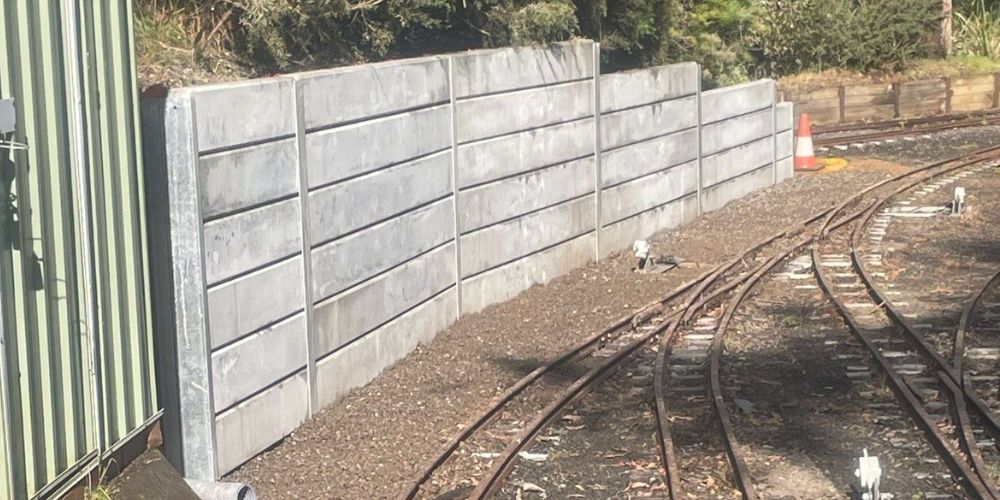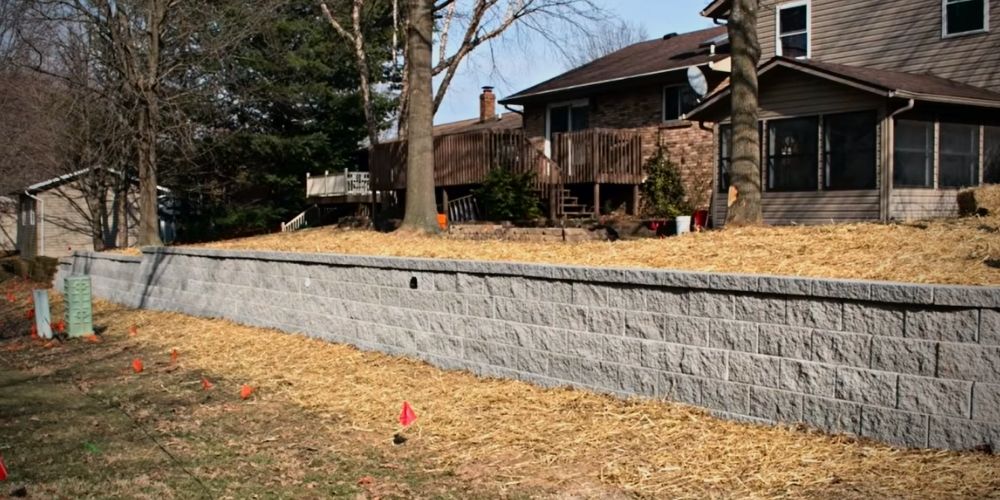How Thick Should a Retaining Wall Need To Be?
If you are building a retaining wall, you are probably asking yourself: How thick should it be? Will it be strong enough to hold back all that soil?
These are smart questions, because getting it wrong is one of the most common (and expensive) mistakes homeowners make. I have seen walls buckle, lean, or even collapse simply because they were not built thick or strong enough for the job.
Here is a simple guide to give you an idea of what thickness and strength really mean in practice:
| Wall Type | Typical Thickness | Best Suited For |
|---|---|---|
| Concrete Retaining Wall | Base = half to one third of wall height | Larger walls, heavy loads, driveways |
| Timber Retaining Wall | Posts at least 125 mm thick | Garden beds, decorative features |
| Block or Stone Wall | Around 200 mm thick | Medium loads, landscaping |
| Engineered Walls 2.5m+ | Custom engineered design | Steep slopes, high loads, compliance required |
The key takeaway is this: small garden walls can be simple, but once you are holding back serious soil or building above one metre, the thickness and strength need to be properly engineered. Otherwise, you are inviting problems down the track.
When we design walls for our clients, we always think long-term: Will it last? Will it stay straight after years of rain and shifting soil? Will it still look good when they are ready to sell the property?

Why Is Retaining Wall Thickness Important?
Let me put it this way: a retaining wall is not just a stack of timber or concrete. It is a barrier that holds back tonnes of pressure, day in and day out. If that barrier is too thin, or built without considering the soil and drainage, it will eventually give way.
We had a client in Whittlesea who built a DIY timber wall about 1.2 metres high. On the surface, it looked fine. But the soil behind it was clay, and without proper drainage the wall started leaning after only two winters. By the time we were called in, the posts were rotting and the wall was unsafe.
That client said to us, “I just wanted something quick and cheap, but now I am paying twice.” We rebuilt their wall with concrete sleepers and heavy-duty posts, properly engineered for their soil type. Now they have peace of mind knowing it will not budge.
Load-Bearing Capacity
A retaining wall’s ability to support weight directly correlates with its thickness. Generally, a bigger wall can withstand larger loads and stronger lateral pressures from the retained dirt.
Stability
The pressure from the retained material and the effects of outside elements like water buildup are two forces that retaining walls must withstand. Thicker walls provide greater stability and a lower chance of failure or collapse.
Prevention of Bulging or Tilting
Insufficient thickness might cause the retaining wall to bulge or tilt when exposed to significant lateral pressure from the held material. A thicker wall can withstand these pressures and keep its vertical alignment better.
Durability
In general, thicker walls are stronger and last longer. They are more resilient to the impacts of weathering, erosion, and other environmental elements that may eventually compromise the wall’s structural integrity.
Design Considerations
The required thickness will depend on the particular design requirements of a retaining wall, which include the wall’s height, the kind of soil it is holding back, and the slope of the land. Following appropriate design rules and standards is essential to guaranteeing the retaining wall’s efficacy.
Safety
A sufficiently thick retaining wall is necessary for nearby people and property safety. A wall that has been built shoddily or with poor design may collapse and cause harm to people or property.
Compliance with Regulations
Minimum thickness standards for retaining walls are frequently specified by building rules and regulations, considering variables including height, soil type, and location. Respecting these rules is necessary to guarantee the structure’s safety and legal compliance.

How To Calculate The Thickness of the Retaining Wall
As a Melbourne retaining wall builder, I know how crucial it is to have a well-thought-out and well-built retaining wall to guarantee the stability and longevity of your property.
While seeking the advice of a qualified engineer is essential for precise computations, you can use these guidelines when determining the thickness of a retaining wall:
Determine the Height of the Retaining Wall (H):
Calculate the vertical distance between the soil retention point at the top of the wall and its base. This height plays a crucial role in figuring out the wall’s thickness.
Consider the Slope of the Terrain
Analyse the land’s slope behind the wall. Steeper slopes may impact the stability of the retaining wall because of the increased lateral pressure on it. The slope angle is a feature that engineers consider in their designs.
Check Local Regulations and Guidelines
Building laws and regulations regulate construction projects in Melbourne, just like they do in any other region. To ensure these criteria are followed, check with the local government or seek advice from an expert.
Use a Rule of Thumb for Residential Applications
Some builders uses a thumb rule stating that the retaining wall’s thickness should be at least one-tenth of the wall’s height as a quick reference for residential applications. For instance, 0.4 feet (4.8 inches) of thickness might be the beginning point if the wall is 4 feet high.
Consider Drainage Needs
An effective drainage system is essential to a retaining wall’s stability. Because too much water might raise soil pressure, consider the drainage situation on your land. Sufficient drainage arrangements can affect the wall’s thickness and design.
Consult with a Professional Engineer
Speaking with a skilled engineer is imperative for a site-specific study, even though these guidelines offer a fundamental understanding. Engineers consider additional aspects such as safety factors, surcharge loads, and soil-bearing capability to offer an accurate thickness assessment.

How Thick Should a Retaining Wall Be? By Wall Type
- Concrete retaining walls: The base should be about half to one third of the wall’s height. For example, a 2 metre wall should be roughly 700 mm thick at the base.
Timber retaining walls: Posts need to be at least 125 mm thick, spaced correctly, and concreted into the ground.
Block or stone walls: Typically 200 mm thick or more, but they must be reinforced and properly backfilled.
By Site Conditions
Wall thickness depends on more than just the material. You need to consider:
Soil type. Clay is heavy and holds water, which adds more pressure. Sandy soil shifts more easily, so it requires reinforcement.
Wall height. The higher the wall, the greater the force pushing against it. Pressure multiplies quickly as you go up in height.
Drainage. Without proper drainage, water builds up behind the wall, creating hydrostatic pressure that can double the load.
Additional loads. A car parked behind the wall, or even a water tank or shed, adds significant weight that must be factored in.
We always start with a site inspection. What works for one property may not work for another, even if the walls are the same height.
Retaining Wall Thickness Calculator
We formulated here a retaining wall thickness calculator which you can use to have an idea. It’s a simple way to gauge the thickness you might need for your retaining wall project.
But remember, this is not a substitute for a professional engineering analysis or retaining wall builder consultation. It’s still best to talk to the expert personally to better understand what you need and avoid bigger problems in the future.
So, feel free to use the calculator as a starting point, but when it comes to ensuring the stability and effectiveness of your retaining wall, expert advice is key.
Retaining Wall Thickness Calculator
Standard Size of a Retaining Wall
The ideal thickness for retaining walls varies depending on the site-specific features and design specifications. Hence, there needs to be a universally applicable standard thickness. Engineering calculations are used to calculate the thickness of retaining walls, considering several aspects such as the wall’s height, soil composition, terrain slope, and local building codes.
Nonetheless, as a general rule of thumb for residential applications:
Short Walls (up to 4 feet):
Typically, thickness begins around 8 to 12 inches.
Medium Walls (4 to 10 feet):
The thickness can vary between 12 and 18 inches, contingent upon slope and soil characteristics.
Taller Walls (10 feet and above):
Thickness increases significantly and may require engineering expertise. Walls of this height often require special design considerations and reinforcements and may need to comply with specific local regulations.
DIY vs Professional Retaining Wall Construction
The Risks of DIY
Building a small garden wall yourself can be a fun project. But once you go over one metre, the risks increase. We see DIY walls that are too thin, built without drainage, or using materials that were never meant to handle the loads.
Most of these walls last a few years before they fail. By then, repairing or rebuilding usually costs more than if it had been done properly the first time.
The Benefits of Professional Design and Construction
When you bring in Hammer Excavations, you get:
Walls designed specifically for your soil, slope, and load.
Full compliance with council regulations and Australian standards.
Quality construction that lasts for decades.
Peace of mind that you will not be rebuilding in five years’ time.
We are not just building walls. We are building safety, durability, and value into your property.
Why Choose Hammer Excavations
- Experience: We have worked across Melbourne and regional Victoria, tackling everything from small garden walls to large engineered systems.
Local Knowledge: We understand the challenges of clay soils, sloped blocks, and varying drainage conditions.
Client Trust: Many of our projects come from referrals, which says a lot about the confidence our clients have in us.
One of our clients in Doreen told us after their project, “I can finally stop worrying every time it rains. The new wall just feels solid.” That is exactly the kind of confidence we aim to deliver.
Frequently Asked Questions
Indeed, levelling down steep ground for parking lots or roadways can be accomplished with retaining walls. Proper design and construction are crucial to guarantee stability and durability under the increased load.
Although retaining walls can be constructed on various soil types, the soil’s cohesion, drainage, and compaction greatly influence the design. Certain types of soil could need further attention.
To improve aesthetics or accommodate topographical changes, retaining walls can be constructed with curves or stairs. Stepped and curved walls could call for extra materials and architectural concerns.
Retaining wall selection is influenced by soil type, height, budget, and aesthetic choices. Speak with an expert to evaluate your requirements and choose the best action.
Conclusion
Understanding how thick your retaining wall should be is key for a strong and lasting structure. Consider the height, the soil, and local rules. Now that you know the basics, check your own space. But remember, consulting a pro is smart for precise advice. Talk to your trusted retaining wall builders to make the right choices for a robust structure.
A retaining wall is an investment in your property’s safety and value. If it is too thin or weak, you will be back to square one within a few years.
At Hammer Excavations, we build walls that last. Whether it is a small garden bed or a large engineered solution, we will make sure your wall is thick, strong, and compliant.
Call us today, book your inspection, and let’s build it right the first time.
